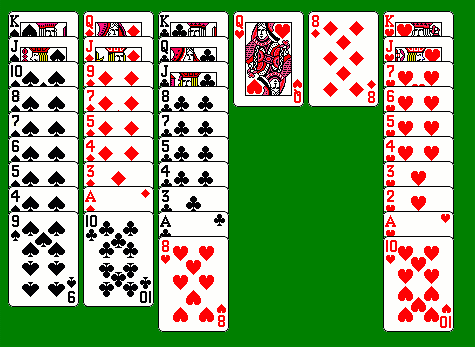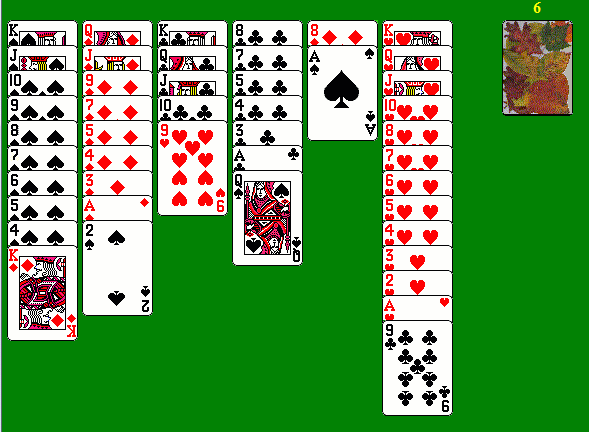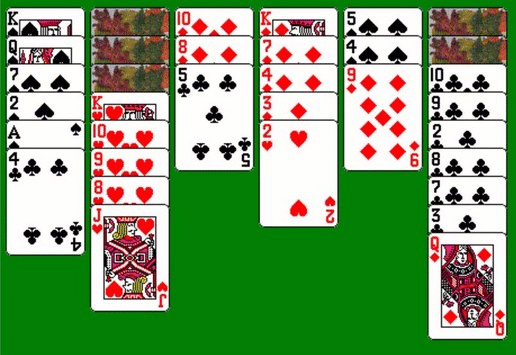
This is deal number 17115 in my demo version. You can play it out with a real deck of cards, but you will have to prearrange the deck in the following order:

I wish there were an annual award for the best new solitaire game: my nominee for 2007 would have been Toby Ord's recent game Autumn Leaves. In this game, Toby has added one brilliant new mechanism to Spider-like games to create an original one-deck game with a pleasing mixture of skill and luck. The rules have been carefully thought out: while many games can be played with various sizes of tableau, Autumn Leaves uses a tableau of six columns almost by necessity: five would create an excessively hard game and seven far too easy. Unlike conventional Spider, completed suites are not removed; this makes the endgame a little more challenging (it would be almost impossible to lose once one suite was completed, if they could be removed). Ord named the game Autumn Leaves "because of the way the cards flutter back and forth between the piles, which can be quite hypnotic after a while". With his permission I am presenting the game here, with a sample deal played through and some notes on basic strategy.

This is deal number 17115 in my demo version. You can play it out
with a real deck
of cards, but you will have to prearrange the deck in the following
order:
JS QD KC 4D 4S 4C 3H 7S 3D AH KS QC 4H 3C 2H 5S 5H AC 6H KH 6S
5C 9D
8S TS JD
AD 8C 7D JC 5D JH 7H 7C 9S TC 8H QH 8D TH KD 2S 9H QS AS 9C 2C 6D 3S TD
2D 6C
Note that the tableau consists of six columns of four cards each,
except that the two
central columns have only three cards each. The top card of each row is
face up; the
remainder are face down. The remaining 30 cards form a stock, which is
dealt six cards at
a time, Spider-style, one to each column. Cards may be moved
column-to-column, packed
downwards in suit, but not necessarily consecutively: that is, a card
may be placed onto any
higher card of the same suit. In the initial position above,
the two of hearts
can be moved onto either the six or king of hearts, or the five of
spades may be moved
onto the six. But there is a benefit to packing consecutively: as in
Spider, consecutive
groups of cards of the same suit may be moved as a unit. Let's see how
that works as we
play through this deal.
It is usually wise to make consecutive-packing plays first, so
we
pack the five of
spades onto the six of spades, exposing the ace of hearts, which is
packed onto the two of
hearts. Now we have several nonconsecutive hearts we plan to pack on
each other. The
higher cards should be played first, so the six of hearts is packed
onto the king,
exposing the four of hearts which is packed onto the six of hearts,
which in turn exposes
the three of hearts which is added on. Next the two and ace of hearts,
which can be moved
as a unit since they form a consecutive sequence, are added to the
string of hearts in
column two. There is no need to worry at the moment that the hearts are
not a continuous
sequence; sequences like this can later be moved once you have empty
columns, and eventually filled in as you uncover more cards and deal
more cards from the stock.

Moving the two and ace of hearts exposes the three of diamonds, which
is packed on the
four of diamonds. The king of clubs turns up, onto which is packed the
five and then the
ace of clubs, exposing the queen of clubs which cannot be moved yet.
The six and five of
spades can be packed as a unit onto the jack of spades, and the five of
hearts appears
next. This can be inserted between the four and six of hearts by moving
the four and the
lower cards onto the five and the whole group back onto the six. When
the king of spades
appears, we are blocked. We therefore deal a new set of six cards:

We are not afraid to stack up all of the loose diamonds out of
order, especially since
the fourth column has no facedown cards and is all one suit. We pack
the nine and ace of
diamonds onto the jack, planning to unravel that suit later. When there
are three or more
columns with the same suit exposed, we can use the Tower of Hanoi
technique to consolidate
the cards of that suit. Since any card or group of
consecutive cards in suit
can be moved into an empty column, we particularly want
to clear column 1,
so we pack the six-five of spades onto the eight, and the jack,
followed by the ten, onto
the king. Now we have an empty column and can move the two separate
pieces from column 2
to column 5, putting the six-five temporarily into column 1, the eight
onto and the ten,
and the six-five back onto the eight. In the Solitaire Virtuoso program, right-clicking a card will
automatically move it (and any other connected cards) into the first
available empty column -- this makes complex sequences of moves, with
practice, a little quicker. Using the empty columns is
somewhat similar to
the use of
supermoves in FreeCell.

With only one column empty, we cannot sort the diamonds in column 4 or move the two pieces of the heart suit off of column 2, but we can move the clubs from column 6 to expose another card. We move the eight of clubs into the empty column 1, shift the five and ace onto it (using the queen to momentarily hold the ace; a high card of the suit being moved is almost as good as an empty column), and pack the queen onto the king. If we are lucky, the card under the queen can be moved (2C, 9C, TC, JC, 7H, AS, 2S, 3S, 4S, or 2D would all be packed easily). In fact the four of clubs turns up, but this can be packed by another series of maneuvers: ace on queen, four on five and both back to column 6 (followed by the ace onto the four), eight onto queen, and the five-four and ace onto the eight using the now empty column 1.

There are now two empty columns, so we can either sort the
diamonds
or move the hearts
(the spades could also be moved, but they would break into two pieces
and fill both
columns -- the hearts are also preferable to spades because they cover
more
cards). We can sort the
diamonds and still end up with two empty columns, so we should do that
before moving the
hearts, which will fill one column and expose unknown cards. The ace of
diamonds goes into
one column, the nine into another, and the ace back onto it. The jack
then goes into the
column still empty, the ace onto the three, the nine onto the jack, and
the four-three and
ace onto the nine. In fact, with two empty columns, using the Tower of
Hanoi technique, any
set of cards of the same suit can be sorted regardless of how many
pieces it has.
Since this still leaves two empty columns, you should always sort every
column containing a single suit, before making other plays, whenever
you have two empty columns.
Now we have two empty columns, and the hearts are only in two pieces,
so we want to move them now, since we can do so and still have one
empty column left. Move the six-ace into one, the king
into the other
(exposing the three of clubs which cannot be moved yet), and the
six-ace back onto the
king. Now the ace can be moved into the empty column momentarily to
allow the three of
clubs to be packed onto the four (exposing the seven of spades), before
packing the ace
back onto the three. This insertion play
is very common. The seven of spades can be inserted between six
and eight as we saw
earlier (since these cards are consecutive, the empty column isn't even
needed). The queen of diamonds turns up, and by another Tower of
Hanoi
sequence we can
pack all of the other diamonds onto it (ace to empty, four-three to
queen, ace to three,
nine to empty, ace to jack, four-three to nine, ace to three, jack to
queen, ace to jack,
four-three to empty, ace to three, nine to jack, ace to empty,
four-three to nine, ace to
three). Note that in moving these long sequences, the
first move goes to the target if there are an odd number of pieces, but
to the empty space if there are an even number of pieces.

Now we have only one card face down, and all the other suits are in sequence, so we shift the spades off of column five. Eight-five goes to an empty column, jack-ten to the other, eight-five onto ten, and king to empty. The four of spades turns up, we pack it onto the five, then move both pieces onto the king. We now have an ideal position, with four suits, in correct order, in separate columns, with two columns empty. We can't do any better than this, so we deal six more cards.

Now the suits need to be untangled again. Since the hearts
can be most easily
repacked, we move the seven of clubs onto the jack, the ace-through-six
of hearts onto the
seven, the jack of hearts onto the king, and the ace-through-seven of
hearts onto the
jack. We choose to fix the clubs before the diamonds (since jack and
seven of clubs block the bulk of the diamonds), so
we next move the
five of diamonds onto the seven, the ace and three-four-five of clubs
to the two empty
columns (and then the ace onto the three), the seven of clubs onto the
eight and then both
to an empty column, and then reassemble all of the club pieces onto the
queen (jack,
seven-eight, ace to empty column, three-four-five, and ace). Finally
the diamonds
can be reassembled in the same way (ace to empty, three-four to five,
three-four-five to
empty, seven to nine, three-four-five to seven and ace to
three). We deal six
more cards:

The hearts are easy to fix: ten to queen, ace-through-seven to eight, ten to jack, ten-jack to queen, ten-jack-queen to king, and ace-through-eight to ten. We see that we can fix the spades with only one empty column: nine to empty, four-through-eight to nine and back to the ten. Moving the ten of clubs will block both clubs and diamonds, so instead we do a club maneuver, aiming at least to get the ten of clubs onto the jack. This requires getting the seven-eight into the empty column, so we play ace to empty column, three-four-five to ten, ace to three, seven-eight to empty column, ace to jack, three-four-five to seven, ace to three, and ten to jack. With 12 cards left in the stock, we have no empty columns, but all of the cards are exposed and there are no columns with mixed suits. Our chances of winning are very good. We deal the next six cards from the stock:

The ace of spades clearly goes onto the two. Playing the eight of diamonds onto the king empties a column, and allows us to swap nines by playing the nine of hearts to the empty column, the nine of clubs to the ten, the ace-through-eight of hearts onto the nine and back onto the ten, completing the hearts. Remember that, unlike Spider, the complete suite of hearts cannot be removed. Playing the queen of spades to the empty column does not allow us to consolidate the clubs, so instead we play the ace-two of spades onto the queen and tackle the diamonds instead. What we want to do temporarily is to stack all of the diamonds in order onto the king in column 1, to create two empty columns to use on the clubs.
We play the ace to the eight and the three-four-five to the empty column, then the ace to the three. After inserting the eight between the seven and nine, we play ace to seven, three-four-five to king, and ace to three, allowing us to move seven-eight-nine to the empty column. Next ace to jack, three-four-five to seven, and ace to three, freeing up the jack-queen to go onto the king. You should by now have the hang of the Tower of Hanoi sequences, so I won't detail the moves for the succeeding operations: finish piling up the diamonds (three pieces in column 5, so the ace goes to the jack first), move the two-piece group of spades to an empty column, and consolidate the clubs. Unfortunately, the diamonds we stacked up are in too many pieces to get into one column: the best we can do is to get the jack-queen-king into one column and the rest into another. We are very close to victory as we deal the last six cards from the stock:

The rest is easy: the diamonds come together easily (six to ten, ace to two, etc.). We play the ace-two of spades to the three and back to the queen. The clubs and spades follow easily, giving us four complete suites and a win.
Three-column maneuvers

It may not always be obvious in what order to make plays in consolidating suits in three different columns, so a few examples are above. (Only the columns involved are shown; the other three columns in each case contain other suits. All of these examples are from actual play). In the first example, we want to get all of the other hearts onto the jack, but moving five to seven and ten to jack doesn't work: instead move ace-five to jack, seven-nine to ten (reducing from four pieces to three), ace-five to empty first column, seven-ten to jack, and ace-five to seven (with an empty column left). In the second example, nine to ten may not work if the face down card can't be played elsewhere: instead three to ten, eight to nine, three to empty column, eight-nine to ten (turning up a face down card), and three to eight (with at least one empty column, depending on what the face down card is). The third example is a little harder: ace-two to nine, four to six, ace-two to four, nine-ten to queen, ace-two to nine, four to empty column, ace-two to four, six-eight to nine (turning up a face down card). If the face down card can be played elsewhere, we can then move the other two pieces onto the six.
A more complex example

The above position occurred after the second set of six cards
from the stock. How can we untangle as many cards as
possible? A good principle to remember is that it is better
if the visible cards in one suit are either in one column, or three or
more: two columns is bad unless there is an empty column.
Moving the four of clubs onto the five would put the clubs into two
columns. Moving the nine of diamonds onto the queen doesn't work
either, since the diamonds in the third column are blocked unless we
can maneuver the clubs first. The correct play is to move
the two of hearts to the jack, opening a third diamonds column.
We want to get the queen of diamonds onto the king to free up the
clubs, so we move three-four and seven onto the nine (using the queen
to hold the three-four for a moment). Now the queen on
diamonds goes to the king, three of clubs to the four, five to the
seven, and three-four to the five.

The new position is shown above. We want to get all
of the diamonds onto the king-queen, to make an empty column.
Move the three-four of diamonds onto the queen, and insert the eight
between the seven and nine (seven to eight, seven-eight to nine).
At this point we will be stuck if we move seven-nine onto the ten:
instead play three-four to seven, ten to queen, three-four to empty
column, seven-nine to ten, and three-four to seven. Now we
can insert four-five of spades into the first column and leave two
empty columns. Now get the hearts in order (two and jack to
empty columns, eight-ten to jack, eight-jack to king, and two to
eight). The hearts are in three pieces, so moving them all
from the second column will use up both empty columns.
Instead fix the clubs (three-five and seven-eight to empty columns, two
to three, and seven-eight to nine). Now we move seven-ten to the
empty column, and two-five to seven. This is the best we could do
from the first position shown: all four suits are in single columns,
with an empty column and a column of face down cards. If the face
down card is playable, we may be able to go further, but we will leave
it at this point, except to say that the deal (number 36749) was
eventually won.
Here is a link to Toby Ord's site, giving his own description of the
game. There is also a computer version in BVS Solitaire.
This article is copyright ©2024 by Michael Keller. All rights
reserved. Last edited on November 17, 2024.
All rights to the game of Autumn Leaves
belong to Toby Ord.